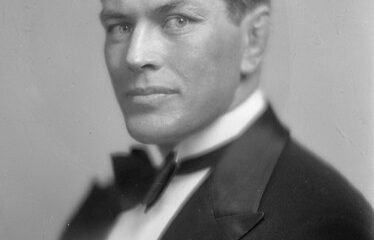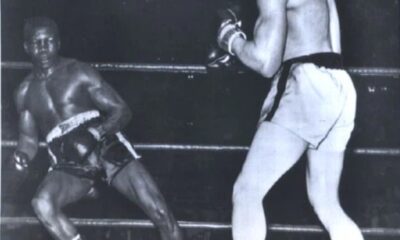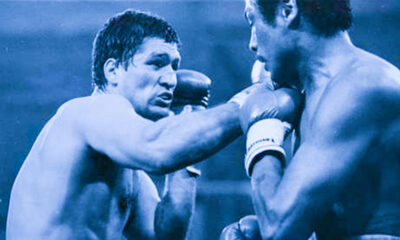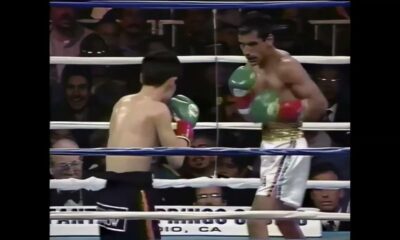Featured Articles
This Day in Boxing History: Rumble in the Jungle: The Night Ali Shocked the World
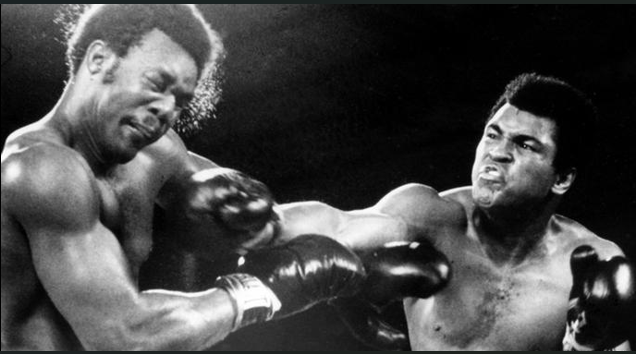
On October 30, 1974, the world witnessed a spectacle that transcended sports. In the humid heart of Kinshasa, Zaire, Muhammad Ali faced the formidable George Foreman in what would become known as the “Rumble in the Jungle.” This fight was not merely a contest of strength, but a convergence of politics, culture, and raw human will.
Just days before the original fight date, Foreman suffered a significant cut above his right eye during a sparring session. The injury required 11 stitches, prompting a five-week delay. However, the ramifications were more profound than a mere postponement. Zaire’s President Mobutu Sese Seko, fearing that the fighters might not return, imposed a travel ban on both Ali and Foreman.
As the world turned its attention to Kinshasa for the highly anticipated “Rumble in the Jungle,” a darker narrative unfolded behind the scenes. President Mobutu Sese Seko, eager to project an image of order and stability to the international community, took extreme measures to ensure the event proceeded without disruption.
In the days leading up to the fight, Mobutu’s regime reportedly rounded up hundreds of individuals deemed undesirable—ranging from petty criminals to political dissidents—and detained them beneath the stadium where the bout was to take place. While some accounts suggest that up to 100 of these detainees were executed, concrete evidence remains scarce, and the full extent of these actions is still a subject of debate among historians.
The rationale behind these drastic measures was clear: Mobutu sought to eliminate any potential threats to the event’s success and, by extension, to his regime’s image. By showcasing a spectacle unmarred by civil unrest, he aimed to present Zaire as a nation under control, capable of hosting a global event without incident.
When the fighters entered the ring in the early hours of October 30, 1974, Foreman held the heavyweight title, but Ali owned the hearts of the crowd. The chants of “Ali bomaye!”—meaning “Ali, kill him!”—echoed through the 20th of May Stadium, a thunderous affirmation of the challenger’s popularity among the local fans.
To accommodate American television audiences, the bout began at 4:30 a.m. under the glare of floodlights, in air so humid it seemed to cling to the fighters’ skin. The temperature hovered near 80°F, with the thick night air amplifying every breath and bead of sweat. Foreman looked menacing and powerful, while Ali appeared loose, confident, and defiant—taunting his opponent even before the first punch was thrown.
In the opening rounds, Foreman came forward with the kind of raw aggression that had dismantled Joe Frazier and Ken Norton—both of whom Ali had struggled against. His punches were thunderous, each one thrown with knockout intentions. Ali, however, surprised both fans and commentators by not dancing away as expected. Instead, he stood his ground, countering with lightning-fast jabs and sharp right hands that snapped Foreman’s head back.
By the third round, the tone of the fight had changed. Ali began leaning back into the ropes, covering up, allowing Foreman to pound his arms and body. At first, it looked suicidal—why would a lighter man invite the punches of one of the most powerful heavyweights in history? But Ali was playing a deeper game, one few could see unfolding in real time.
Each exchange drained Foreman’s reserves. The young champion was punching with full force into Ali’s defense, the effort sapping his strength in the sweltering heat. Ali, meanwhile, conserved energy, occasionally lashing out with sharp counters and taunting Foreman with lines like, “That all you got, George?”
In the fourth round Ali realized that George was getting tired and began talking to him, ‘Come on, sucker, show me something. I can’t feel it. You ain’t nothing but a chump. You done run out of gas, now I’m gonna kick your ass.’”
By the fifth and sixth rounds, Foreman’s swings were slower, his breathing heavier. Ali, alert and calculating, began to sense the shift. The crowd could feel it too—each jab from Ali drew cheers, each missed hook from Foreman drew gasps. The tide was turning.
Unbeknownst to most viewers, the fight’s dynamics were subtly shaped by an overlooked detail: the looseness of the ring ropes. Before the bout, it was evident to both camps that the ropes sagged more than usual—beyond standard tension. The ropes had been tightened as much as possible, but due to the extreme heat they continued to sag. Apparently, Ali seemed to fully understand how to use them to his advantage.
Those slack ropes became the cornerstone of what would later be immortalized as Ali’s “rope-a-dope” strategy. By leaning back deeply, Ali allowed his upper body to recoil just enough to absorb Foreman’s heaviest blows, minimizing their damage. The ropes acted almost like a cushion, dispersing the force while letting Ali rest and regroup.
Foreman, meanwhile, believed he was wearing Ali down—but in reality, he was being lured into exhaustion. Every missed hook, every punch that met glove or shoulder, drained the champion’s endurance. It was a psychological chess match disguised as a slugfest.
It’s been said that at the start of the eighth round, Ali said, “Now it’s my turn” and then went on the attack. As Foreman lunged forward once more, Ali sprang from the ropes with a lightning-fast five-punch combination—a left hook, a right cross, and a flurry that ended with Foreman collapsing onto the canvas. The crowd erupted. The count reached ten. What many had believed to be the impossible had happened.
Muhammad Ali, written off by many as past his prime, had reclaimed the heavyweight championship of the world. The roar of “Ali bomaye!” filled the humid air like a hymn of redemption.
As if the night needed more drama, a fierce storm erupted immediately after the fight. The torrential downpour, accompanied by high winds, wreaked havoc on the outdoor venue, flooding parts of the stadium and causing significant damage to the surrounding areas. While the storm itself didn’t directly impact the fight, the chaotic aftermath mirrored the tumultuous events surrounding it.
The “Rumble in the Jungle” was more than a boxing match; it was a microcosm of the era’s political tensions, cultural upheavals, and the indomitable human spirit. Ali’s victory was not just a triumph in the ring but a testament to resilience, strategy, and the power of belief. As we reflect on that historic night, we are reminded that sometimes, the most significant battles are fought not just with fists but with heart and mind.
-
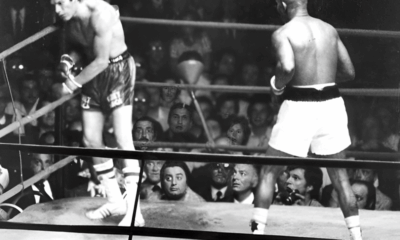
 Featured Articles4 weeks ago
Featured Articles4 weeks agoThis Day in Boxing History: From St. Louis to Buenos Aires
-
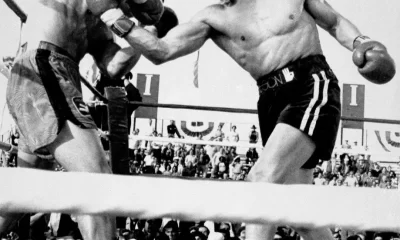
 Featured Articles4 weeks ago
Featured Articles4 weeks agoThis Day in Boxing History: A Date for Heavyweights, Shockwaves and Momentum
-
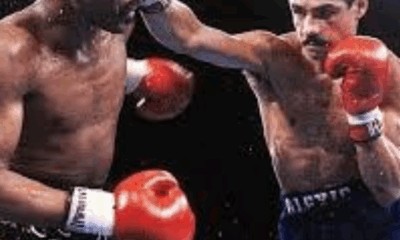
 Featured Articles4 weeks ago
Featured Articles4 weeks agoThis Day in Boxing History: Legendary Fights Across Four Decades
-
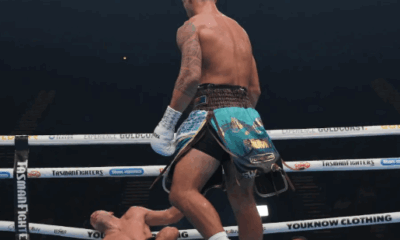
 Featured Articles5 days ago
Featured Articles5 days agoResults from Australia where Cruiser Champ Jai Opetaia Starched Another Overmatched Foe
-

 Featured Articles1 week ago
Featured Articles1 week agoMichael Hunter vs Eli Frankham: A Strange Match-Up at a Storied Venue
-

 Featured Articles2 weeks ago
Featured Articles2 weeks agoAvila Perspective, Chap. 353: ‘Pacman’ at Pechanga and More
-
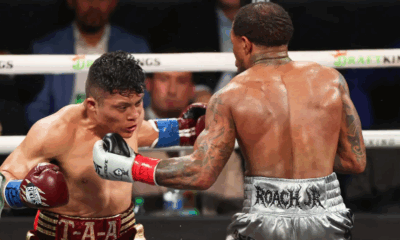
 Featured Articles4 days ago
Featured Articles4 days agoResults from San Antonio where Cruz vs Roach Ended in a Stalemate
-

 Featured Articles3 weeks ago
Featured Articles3 weeks agoThis Day in Boxing History: Ali’s Cruel Lesson, Tyson’s Arrival, and Pacquiao’s Masterclass

